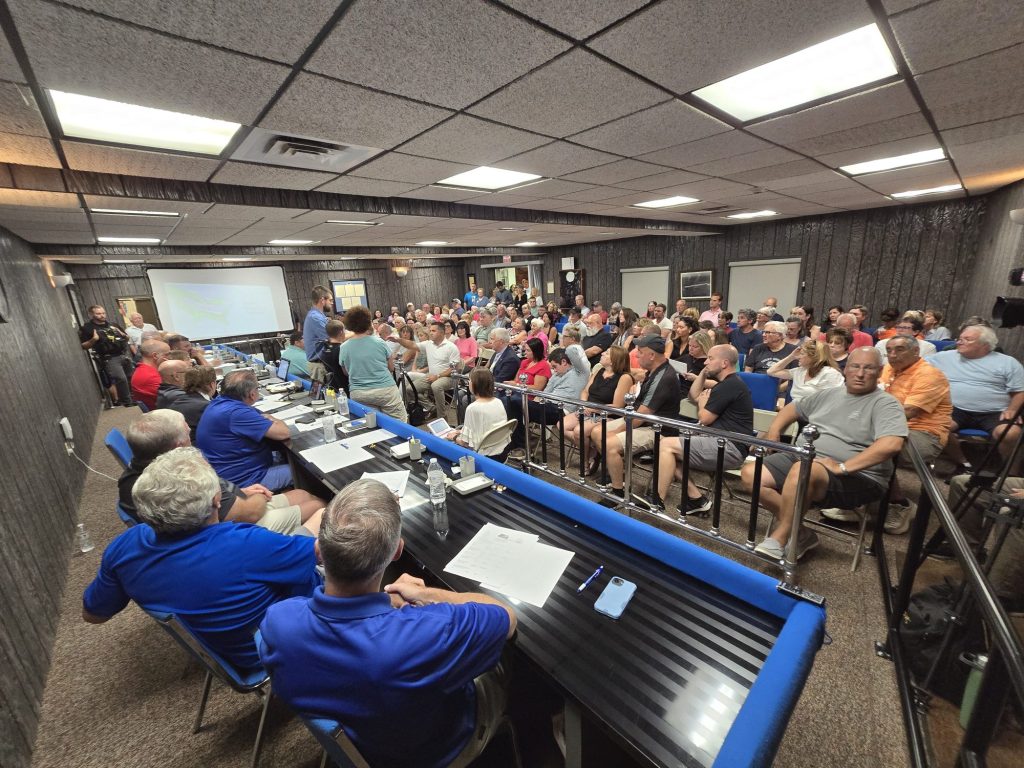Blakely Borough Council will vote next month to limit data centers to the northwest corner of the town above Business Route 6 while also applying nearly three dozen conditions and restrictions to any future data center developments.
Two months after 100-plus residents packed the Blakely Borough Building to oppose a now-withdrawn data center project proposed for residential land near their homes, borough council voted Monday to advertise a zoning amendment that will regulate data centers. The amendment will make them conditional uses in a single section of town, requiring developers to adhere to dozens of conditions and attend a public hearing before council considers approving their request. Council unanimously voted to advertise the zoning amendment and scheduled a public hearing for Nov. 17 at 6 p.m. at the Borough Building, 1439 Main St., Peckville, said borough Manager Chris Paone, who is also Blakely’s zoning officer. Council will hold a meeting to vote on the ordinance immediately following the hearing, Paone said.
The zoning amendment defines data centers and related terms, establishes mandatory conditions; and regulates fuel and battery generators and energy storage facilities. It also adds zoning for short-term rentals — something Paone said the borough has been looking at for a couple years.
Paone said he spent close to two months working on the ordinance by researching data centers, including in Loudoun County, Virginia, which is nicknamed “Data Center Alley” due to the volume of data centers; reviewing data center ordinances in Archbald and Jessup as well as elsewhere in the state; and consulting with the borough’s solicitor.
“We wanted to, No. 1, protect the residents while doing our legal obligation to allow a data center somewhere within the boundaries of the borough,” he said. “We also wanted to listen to the comments and concerns of citizens that they made during meetings that we’ve had, conversations that myself and other council members have had with residents.”
Blakely’s zoning ordinance, which council adopted in February 2017 and last amended in December 2020, did not mention data centers, though the borough pointed to a provision governing unlisted uses as an early protection as it worked on the data center ordinance.
The proposed amendment and accompanying map create a data and technology overlay on wooded land north of Business Route 6 and west of Scott Road, or Route 347, extending to the borough’s northwest border with Dickson City and Scott Twp. The land falls into an S-2 zone, or an open space/conservation district. Other intensive conditional uses in that S-2 zone include sanitary landfills, solid waste facilities and fracking. Unlike rezoning, an overlay district conditionally allows data centers on the land while retaining the underlying zoning designation.
The borough chose the location to keep data centers as far away from residential uses as possible while still staying within the law, Paone said.
“Above Route 6 has the least amount of residential (homes),” he said. “You need to give them enough room to be able to build a center, but you don’t have to give them enough room to build a hyper campus.”
Most notably, the borough mandates that, before council considers their request, data center developers have to conduct environmental impact, health and sound/noise studies at their expense with a qualified professional chosen at the discretion of the borough to maintain impartiality, Paone said.
In the noise section of the ordinance, Blakely not only requires data centers to abide by the standard dBa noise requirements, but also dBc requirements, which are lower-frequency sounds below what humans can hear that still affect people, he said.
The borough also limits data centers to being 40 feet tall, which is the same maximum height allowed in its manufacturing district, prohibits data centers from using any type of on-site electrical generation and requires them to be built on a minimum of 20 acres, Paone said.
Other conditions in the ordinance include that data centers:
• Must be set back 300 feet from all property lines and road rights-of-way, 300 feet from any property line of residential parcels that aren’t part of the project, and 200 feet from any body of water, watercourse or wetland.
• Abide by all state and federal requirements, including submitting all environmental permitting and reports to the borough.
• Receive electrical power from Blakely Borough Electric Light Company — unlike most municipalities, Blakely administers its own electricity — and reimburse the borough for all expenses required for the service, including engineering, site work, rate calculations and training.
• Allow the borough to access the buildings and grounds at least four times a year for inspections, participate in any emergency management and fire training, and provide the borough’s Fire Department with any required equipment such as foam or vehicles to extinguish a data center fire.
• Provide letters from all applicable public utilities certifying the systems have the capacity to meet facility demands while maintaining the same levels of service for existing residents and businesses.
• Strive to use technologies for water conservation, such as closed-loop or recirculation systems for cooling to reduce the demand for public water, including using stormwater.
• Adhere to numerous guidelines on fencing, lighting, vegetation and other aesthetic elements to reduce their visual impact.
Paone emphasized that the studies and information must be submitted before the borough considers approving a data center as a conditional use.
“You need to have all the information before you can make an educated decision on what is going to happen in our in any town,” he said. “This information has to be in front of the people who make the decision. It can’t be a promise in the future.”
Originally Published: October 21, 2025 at 5:47 PM EDT

